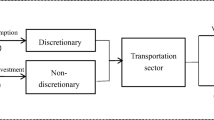Abstract
By enforcing emission reduction policies, the economic effects on different industry are quite diverse. Scientific estimation for this kind of effect has important realistic meaning for the industry development. A multi-objective programing approach integrated with input–output analysis model is used in this paper to evaluate the impact of emission reduction policy on the cost of reducing gas emissions and undertaking industrial adjustment in Chinese vehicle industry. The empirical results show that gas emission control has positive influence on vehicle industry production value. But, this influence is lower than the average macro-economic cost of CO2 emission in China. These policy implications on vehicle industry are less serious than other high emission industries and, at the same time, the enforcement of reduction policy is a chance for new energy vehicle development.






Similar content being viewed by others
References
Agency IE (2010) CO2 emissions from fuel combustion 2010. OECD/IEA, International Energy Agency, Paris
Center CATR (2010) China automotive industry yearbook. In: China automotive industry yearbook, Tianjin
Fujikawa H (2011) Application of the new logistic model to microbial growth prediction in food. Biocontrol Sci 16:47–54
Gang Z, Guangli Z (2008) Selected factors related to car ownership based on econometric models. Auto Indus Res 7:2–6
George JYH, Feng YC (2000) Integrated planning for mitigating CO2 emissions in Taiwan a multi objective programming approach. Energy Policy 28:519–523
Hafkamp W, Nijkamp P (1983) Conflict analysis and compromise strategies in integrated spatial systems. Reg Sci Urb Econ 13:115–140
Hsu GJY, Chou FY (2000) Integrated planning for mitigating CO2 emissions in Taiwan: a multi-objective programming approach. Energy Policy 28:519–523
Ito Y (2000) Adaptive dynamic input-output analysis using neural networks: Japanese industrial structure. Kybernetes 29:1087–1102
Jakapong P, Chumnong S (2010) Relationship between level of economic development and motorcycle and car ownerships and their impacts on fuel consumption and greenhouse gas emission in Thailand. Renew Sust Energ Rev 14(9):2966–2975
Juan Z (2011) R&D for environmental innovation and supportive policy: the implications for new energy automobile industry in China. Energy Procedia 5:1003–1007
Kennemann M, Wriggers FS, Nyhuis P (2009) Economic production identifying optimal economical and logistical measures. In 16th international conference on industrial engineering and engineering management. E&EM, pp 434–441
Liew CJ (2000) The dynamic variable input-output model: an advancement from the Leontief dynamic input-output model. Ann Reg Sci 4:591–614
Manne AS, Richels RG (1991) Global CO2 emission reductions—the impacts of rising energy costs. Energy J 1:87–107
Michael T (1995) Carbon dioxide emissions and global GDP. Ecol Econ 15:215–223
Ministry of Environmental Protection of the People’s Republic of China (2010) China vehicle emission control annual report. Ministry of Environmental Protection of the People’s Republic of China
Oliveira C, Antunes CH (2011) A multi-objective multi-sectoral economy–energy–environment model: Application to Portugal. Energy 36:2856–2866
Pongthanaisawan J, Sorapipatana C (2010) Relationship between level of economic development and motorcycle and car ownerships and their impacts on fuel consumption and greenhouse gas emission in Thailand. Renew Sust Energy Rev 14:2966–2975
Rose A, Stevens B (1993) The efficiency and equity of marketable permits for CO2 emissions. Resour Energy Econ 15:117–146
Wiendahl PH, Breithaupt WJ (2000) Automatic production control applying control theory. Int J Prod Econ 63:33–46
Yang H (2000) Taiwan carbon dioxide reductions associated with energy use cost estimates: based on multi-objective planning application. Hum Soc Sci Bull 12:459–494
Ying F, Xiaobing Z, Lei Z (2010) Estimating the macroeconomic cost of CO2 emission abatement in china based on multi-objective programming. Adv Clim Change Res 2:130–135
Acknowledgments
We wish to acknowledge the sponsors: open fund in 2010 of State Key Combustion Laboratory (K2010-11); Ministry of Education of Specialized Research Fund for the Doctoral Program (200800561065).
Author information
Authors and Affiliations
Corresponding author
Rights and permissions
About this article
Cite this article
Chen, L., Zhang, H. & Guo, Y. Estimating the economic cost of emission reduction in Chinese vehicle industry based on multi-objective programing. Clean Techn Environ Policy 15, 727–734 (2013). https://doi.org/10.1007/s10098-012-0560-8
Received:
Accepted:
Published:
Issue Date:
DOI: https://doi.org/10.1007/s10098-012-0560-8




